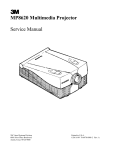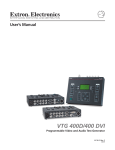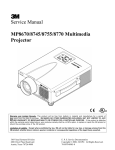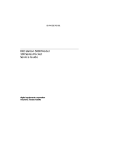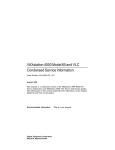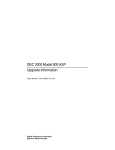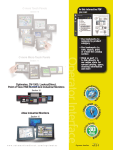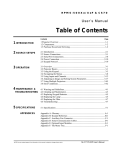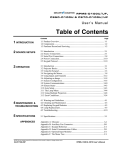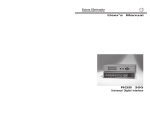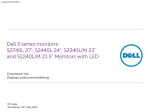Download Extron electronics A-2 User`s manual
Transcript
User’s Manual VTG 150, VTG 200 Video Test Generators www.extron.com Extron Electronics, USA Extron Electronics, Europe Extron Electronics, Asia Extron Electronics, Japan 1230 South Lewis Street Anaheim, CA 92805 USA 714.491.1500 Fax 714.491.1517 Beeldschermweg 6C 3821 AH Amersfoort The Netherlands +31.33.453.4040 Fax +31.33.453.4050 135 Joo Seng Road, #04-01 PM Industrial Building Singapore 368363 +65.6383.4400 Fax +65.6383.4664 Daisan DMJ Building 6F 3-9-1 Kudan Minami Chiyoda-ku, Tokyo 102-0074 Japan +81.3.3511.7655 Fax +81.3.3511.7656 © 2002 Extron Electronics. All rights reserved. 68-194-01 Printed in the USA Precautions Safety Instructions • English This symbol is intended to alert the user of important operating and maintenance (servicing) instructions in the literature provided with the equipment. This symbol is intended to alert the user of the presence of uninsulated dangerous voltage within the product's enclosure that may present a risk of electric shock. Caution Read Instructions • Read and understand all safety and operating instructions before using the equipment. Retain Instructions • The safety instructions should be kept for future reference. Follow Warnings • Follow all warnings and instructions marked on the equipment or in the user information. Avoid Attachments • Do not use tools or attachments that are not recommended by the equipment manufacturer because they may be hazardous. Power sources • This equipment should be operated only from the power source indicated on the product. This equipment is intended to be used with a main power system with a grounded (neutral) conductor. The third (grounding) pin is a safety feature, do not attempt to bypass or disable it. Power disconnection • To remove power from the equipment safely, remove all power cords from the rear of the equipment, or the desktop power module (if detachable), or from the power source receptacle (wall plug). Power cord protection • Power cords should be routed so that they are not likely to be stepped on or pinched by items placed upon or against them. Servicing • Refer all servicing to qualified service personnel. There are no userserviceable parts inside. To prevent the risk of shock, do not attempt to service this equipment yourself because opening or removing covers may expose you to dangerous voltage or other hazards. Slots and openings • If the equipment has slots or holes in the enclosure, these are provided to prevent overheating of sensitive components inside. These openings must never be blocked by other objects. Lithium battery • There is a danger of explosion if battery is incorrectly replaced. Replace it only with the same or equivalent type recommended by the manufacturer. Dispose of used batteries according to the manufacturer's instructions. Consignes de Sécurité • Français Ce symbole sert à avertir l’utilisateur que la documentation fournie avec le matériel contient des instructions importantes concernant l’exploitation et la maintenance (réparation). Ce symbole sert à avertir l’utilisateur de la présence dans le boîtier de l’appareil de tensions dangereuses non isolées posant des risques d’électrocution. Attention Lire les instructions• Prendre connaissance de toutes les consignes de sécurité et d’exploitation avant d’utiliser le matériel. Conserver les instructions• Ranger les consignes de sécurité afin de pouvoir les consulter à l’avenir. Respecter les avertissements • Observer tous les avertissements et consignes marqués sur le matériel ou présentés dans la documentation utilisateur. Eviter les pièces de fixation • Ne pas utiliser de pièces de fixation ni d’outils non recommandés par le fabricant du matériel car cela risquerait de poser certains dangers. Avertissement Alimentations• Ne faire fonctionner ce matériel qu’avec la source d’alimentation indiquée sur l’appareil. Ce matériel doit être utilisé avec une alimentation principale comportant un fil de terre (neutre). Le troisième contact (de mise à la terre) constitue un dispositif de sécurité : n’essayez pas de la contourner ni de la désactiver. Déconnexion de l’alimentation• Pour mettre le matériel hors tension sans danger, déconnectez tous les cordons d’alimentation de l’arrière de l’appareil ou du module d’alimentation de bureau (s’il est amovible) ou encore de la prise secteur. Protection du cordon d’alimentation • Acheminer les cordons d’alimentation de manière à ce que personne ne risque de marcher dessus et à ce qu’ils ne soient pas écrasés ou pincés par des objets. Réparation-maintenance • Faire exécuter toutes les interventions de réparationmaintenance par un technicien qualifié. Aucun des éléments internes ne peut être réparé par l’utilisateur. Afin d’éviter tout danger d’électrocution, l’utilisateur ne doit pas essayer de procéder lui-même à ces opérations car l’ouverture ou le retrait des couvercles risquent de l’exposer à de hautes tensions et autres dangers. Fentes et orifices • Si le boîtier de l’appareil comporte des fentes ou des orifices, ceux-ci servent à empêcher les composants internes sensibles de surchauffer. Ces ouvertures ne doivent jamais être bloquées par des objets. Lithium Batterie • Il a danger d'explosion s'll y a remplacment incorrect de la batterie. Remplacer uniquement avec une batterie du meme type ou d'un ype equivalent recommande par le constructeur. Mettre au reut les batteries usagees conformement aux instructions du fabricant. Sicherheitsanleitungen • Deutsch Dieses Symbol soll dem Benutzer in der im Lieferumfang enthaltenen Dokumentation besonders wichtige Hinweise zur Bedienung und Wartung (Instandhaltung) geben. Dieses Symbol soll den Benutzer darauf aufmerksam machen, daß im Inneren des Gehäuses dieses Produktes gefährliche Spannungen, die nicht isoliert sind und die einen elektrischen Schock verursachen können, herrschen. Achtung Lesen der Anleitungen • Bevor Sie das Gerät zum ersten Mal verwenden, sollten Sie alle Sicherheits-und Bedienungsanleitungen genau durchlesen und verstehen. Aufbewahren der Anleitungen • Die Hinweise zur elektrischen Sicherheit des Produktes sollten Sie aufbewahren, damit Sie im Bedarfsfall darauf zurückgreifen können. Befolgen der Warnhinweise • Befolgen Sie alle Warnhinweise und Anleitungen auf dem Gerät oder in der Benutzerdokumentation. Keine Zusatzgeräte • Verwenden Sie keine Werkzeuge oder Zusatzgeräte, die nicht ausdrücklich vom Hersteller empfohlen wurden, da diese eine Gefahrenquelle darstellen können. Vorsicht Stromquellen • Dieses Gerät sollte nur über die auf dem Produkt angegebene Stromquelle betrieben werden. Dieses Gerät wurde für eine Verwendung mit einer Hauptstromleitung mit einem geerdeten (neutralen) Leiter konzipiert. Der dritte Kontakt ist für einen Erdanschluß, und stellt eine Sicherheitsfunktion dar. Diese sollte nicht umgangen oder außer Betrieb gesetzt werden. Stromunterbrechung • Um das Gerät auf sichere Weise vom Netz zu trennen, sollten Sie alle Netzkabel aus der Rückseite des Gerätes, aus der externen Stomversorgung (falls dies möglich ist) oder aus der Wandsteckdose ziehen. Schutz des Netzkabels • Netzkabel sollten stets so verlegt werden, daß sie nicht im Weg liegen und niemand darauf treten kann oder Objekte darauf- oder unmittelbar dagegengestellt werden können. Wartung • Alle Wartungsmaßnahmen sollten nur von qualifiziertem Servicepersonal durchgeführt werden. Die internen Komponenten des Gerätes sind wartungsfrei. Zur Vermeidung eines elektrischen Schocks versuchen Sie in keinem Fall, dieses Gerät selbst öffnen, da beim Entfernen der Abdeckungen die Gefahr eines elektrischen Schlags und/oder andere Gefahren bestehen. Schlitze und Öffnungen • Wenn das Gerät Schlitze oder Löcher im Gehäuse aufweist, dienen diese zur Vermeidung einer Überhitzung der empfindlichen Teile im Inneren. Diese Öffnungen dürfen niemals von anderen Objekten blockiert werden. Litium-Batterie • Explosionsgefahr, falls die Batterie nicht richtig ersetzt wird. Ersetzen Sie verbrauchte Batterien nur durch den gleichen oder einen vergleichbaren Batterietyp, der auch vom Hersteller empfohlen wird. Entsorgen Sie verbrauchte Batterien bitte gemäß den Herstelleranweisungen. Instrucciones de seguridad • Español Este símbolo se utiliza para advertir al usuario sobre instrucciones importantes de operación y mantenimiento (o cambio de partes) que se desean destacar en el contenido de la documentación suministrada con los equipos. Este símbolo se utiliza para advertir al usuario sobre la presencia de elementos con voltaje peligroso sin protección aislante, que puedan encontrarse dentro de la caja o alojamiento del producto, y que puedan representar riesgo de electrocución. Precaucion Leer las instrucciones • Leer y analizar todas las instrucciones de operación y seguridad, antes de usar el equipo. Conservar las instrucciones • Conservar las instrucciones de seguridad para futura consulta. Obedecer las advertencias • Todas las advertencias e instrucciones marcadas en el equipo o en la documentación del usuario, deben ser obedecidas. Evitar el uso de accesorios • No usar herramientas o accesorios que no sean especificamente recomendados por el fabricante, ya que podrian implicar riesgos. FCC Class B Notice Warning Advertencia Alimentación eléctrica • Este equipo debe conectarse únicamente a la fuente/tipo de alimentación eléctrica indicada en el mismo. La alimentación eléctrica de este equipo debe provenir de un sistema de distribución general con conductor neutro a tierra. La tercera pata (puesta a tierra) es una medida de seguridad, no puentearia ni eliminaria. Desconexión de alimentación eléctrica • Para desconectar con seguridad la acometida de alimentación eléctrica al equipo, desenchufar todos los cables de alimentación en el panel trasero del equipo, o desenchufar el módulo de alimentación (si fuera independiente), o desenchufar el cable del receptáculo de la pared. Protección del cables de alimentación • Los cables de alimentación eléctrica se deben instalar en lugares donde no sean pisados ni apretados por objetos que se puedan apoyar sobre ellos. Reparaciones/mantenimiento • Solicitar siempre los servicios técnicos de personal calificado. En el interior no hay partes a las que el usuario deba acceder. Para evitar riesgo de electrocución, no intentar personalmente la reparación/ mantenimiento de este equipo, ya que al abrir o extraer las tapas puede quedar expuesto a voltajes peligrosos u otros riesgos. Ranuras y aberturas • Si el equipo posee ranuras o orificios en su caja/alojamiento, es para evitar el sobrecalientamiento de componentes internos sensibles. Estas aberturas nunca se deben obstruir con otros objetos. Batería de litio • Existe riesgo de explosión si esta batería se coloca en la posición incorrecta. Cambiar esta batería únicamente con el mismo tipo (o su equivalente) recomendado por el fabricante. Desachar las baterías usadas siguiendo las instrucciones del fabricante. This equipment has been tested and found to comply with the limits for a Class B digital device, pursuant to part 15 of the FCC Rules. These limits are designed to provide reasonable protection against harmful interference in a residential installation. This equipment generates, uses and can radiate radio frequency energy and, if not installed and used in accordance with the instructions, may cause harmful interference to radio communications. However, there is no guarantee that the interference will not occur in a particular installation. If this equipment does cause harmful interference to radio or television reception, which can be determined by turning the equipment off and on, the user is encouraged to try to correct the interference by one or more of the following measures: • Reorient or relocate the receiving antenna. • Increase the separation between the equipment and receiver. • Connect the equipment into an outlet on a circuit different from that to which the receiver is connected. • Consult the dealer or an experienced radio/TV technician for help. This unit was tested with shielded cables on the peripheral devices. Shielded cables must be used with the unit to ensure compliance. Extron’s Warranty Extron Electronics warrants this product against defects in materials and workmanship for a period of three years from the date of purchase. In the event of malfunction during the warranty period attributable directly to faulty workmanship and/or materials, Extron Electronics will, at its option, repair or replace said products or components, to whatever extent it shall deem necessary to restore said product to proper operating condition, provided that it is returned within the warranty period, with proof of purchase and description of malfunction to: USA, Canada, South America, and Central America: Extron Electronics 1230 South Lewis Street Anaheim, CA 92805, USA Asia: Extron Electronics, Asia 135 Joo Seng Road, #04-01 PM Industrial Bldg. Singapore 368363 Europe, Africa, and the Middle East: Extron Electronics, Europe Beeldschermweg 6C 3821 AH Amersfoort The Netherlands Japan: Extron Electronics, Japan Daisan DMJ Bldg. 6F, 3-9-1 Kudan Minami Chiyoda-ku, Tokyo 102-0074 Japan This Limited Warranty does not apply if the fault has been caused by misuse, improper handling care, electrical or mechanical abuse, abnormal operating conditions or non-Extron authorized modification to the product. If it has been determined that the product is defective, please call Extron and ask for an Applications Engineer at (714) 491-1500 (USA), 31.33.453.4040 (Europe), 65.6383.4400 (Asia), or 81.3.3511.7655 (Japan) to receive an RA# (Return Authorization number). This will begin the repair process as quickly as possible. Units must be returned insured, with shipping charges prepaid. If not insured, you assume the risk of loss or damage during shipment. Returned units must include the serial number and a description of the problem, as well as the name of the person to contact in case there are any questions. Extron Electronics makes no further warranties either expressed or implied with respect to the product and its quality, performance, merchantability, or fitness for any particular use. In no event will Extron Electronics be liable for direct, indirect, or consequential damages resulting from any defect in this product even if Extron Electronics has been advised of such damage. Please note that laws vary from state to state and country to country, and that some provisions of this warranty may not apply to you. Contents Introduction to VTG 150 & VTG 200 ..................................... Chapter 1 Introduction .............................................................................. 1-1 VTG 150 Features ................................................................... 1-2 VTG 200 Features ................................................................... 1-2 Specifications .......................................................................... 1-2 Connecting the VTG Output Cables ..................................... Chapter 2 Connecting the VTG Output Cables ........................................ 2-1 15-Pin HD (VGA/XGA) Output ................................................. 2-1 15-Pin Apple/Mac II (VTG 150), MacII/Quadra (VTG 200) Output ............................................. 2-2 9 Pin, TTL Output .................................................................... 2-2 RGB Output (BNC, Analog) ..................................................... 2-3 Composite vs. Separate H & V ........................................ 2-3 Sync on Red, Blue, or Green ........................................... 2-3 NTSC/PAL BNC Output (VTG 200 only) ................................. 2-3 13W3 Sun/SGI/IBM Output (VTG 200 only) ............................ 2-4 Adapting the VTG 150 to Other Standards ............................. 2-4 Monitors with a 13W3 Input Connector ............................ 2-4 Connecting TTL Output to an AT&T 6300 ........................ 2-5 Operating the Video Test Generator ..................................... Chapter 3 Operating the Video Test Generator ....................................... 3-1 Power On ......................................................................... 3-1 Timer LED ........................................................................ 3-1 Exit the Instructional Menu Cycle ..................................... 3-2 View the Scan Ranges ..................................................... 3-2 View the Scan Rates ........................................................ 3-2 Activate a Scan Rate ........................................................ 3-2 Change Scan Rate ........................................................... 3-3 Change Test Pattern ........................................................ 3-3 Change Test Pattern Color .............................................. 3-3 Auto-sequence the Test Patterns ..................................... 3-3 NTSC/PAL LED (VTG 200 only) ...................................... 3-3 Timer ................................................................................ 3-3 Add Sync to a Video Line ................................................. 3-4 Sync Output Selection ...................................................... 3-4 Power Off ......................................................................... 3-5 Application Information ........................................................ Chapter 4 VTG Formats ........................................................................... 4-1 Video Test Patterns ................................................................. 4-3 Setting Up Large Screen Projection Systems ......................... 4-5 Video Setup Guide .................................................................. 4-6 Monitor Applications ................................................................ 4-7 Troubleshooting ....................................................................... 4-9 Page i VTG 200 RS-232 Control and Software ................................ Chapter 5 VTG 200 RS-232 Control and Connection to Computer ......... 5-1 Host/VTG 200 Communications ....................................... 5-2 Using the Command/Response Table ............................. 5-2 Command/Response Table ..................................................... 5-3 Definitions and Abbreviations .......................................... 5-3 Error Code Descriptions ................................................... 5-3 VTG 200 Control Program ....................................................... 5-5 Installing the Software ...................................................... 5-5 Using the Software ........................................................... 5-5 Reference Material ............................................................ Appendix A VTG Software Updates ............................................................ A-1 Part Numbers .......................................................................... A-1 Adapters ........................................................................... A-1 Pre-cut BNC Cables ......................................................... A-1 VGA Male-Female Cables ................................................ A-1 Mac/Quadra Male-Female Cables ................................... A-2 Male-to-Female Cables (Sun/SGI) ................................... A-2 VGA 15-pin HD Male to 15-pin HD Male Cables ............. A-2 Mac/Quadra 15-pin Male to 15-pin Male Cables ............. A-2 13W3 Male-to-Male Cables (Sun/SGI) ............................. A-2 All trademarks mentioned in this manual are the properties of their respective owners. 68-194-01 Rev. C Printed in the USA 04 02 Extron VTG 150 & VTG 200 User’s Manual 1 Chapter One Introduction Introduction Legend of Icons ___ Important information – for example, an action or a step that must be done before proceeding. ___ A Warning – possible damage could occur. _ A Note, a Hint, or a Tip that may be helpful. __ Possible Electrostatic Discharge (ESD) damage could result from touching electronic components. __ Additional information may be referenced in another section, or in another document. Page ii VTG 150 Features VTG 200 Features Specifications Introduction Introduction Introduction VTG 150 Features The Extron VTG 150 and VTG 200 Video Test Generators reproduce computer video signals with patterns for testing and repairing computer monitors, LCD panels, interfaces and large screen displays. They are also used to setup and simulate computer video for system installations. Both the VTG 150 and the VTG 200 have 16 selectable test patterns for setting and testing geometry, focus, convergence, gray scale and other parameters. After a test pattern has been selected, the color of each pattern may be changed to display in the colors white, black, red, green, blue, cyan, magenta and yellow. • Easy operation - When power is applied to the VTG, the LCD displays a series of instructional menus. • Output connectors provide connection to RGB (BNC), TTL, Macintosh and VGA/XGA devices. • Sync output can be composite H/V; separate H & V; Sync on Green; or sync on red, green, and blue. • Automatic time-out to prevent video burn-in • Pre-loaded scan rates - The VTG 150 has been pre-loaded with the most popular video scan rates. • Sixteen test patterns with selectable color combination • Upgrades and options - As new scan formats are introduced, the VTG 150 can be sent to Extron to be upgraded. • Automatic test pattern sequencing for burn-in applications of display and video processing equipment. VTG 200 Features The VTG 200 Video Test Generator has all of the features of the VTG 150 listed above plus: • 13W3 output connector for Sun, SGI, IBM Power PC and NEXT type monitors • NTSC/PAL BNC output connector • SMPTE color bar and PLUGE test pattern for NTSC/PAL • RS-232 connector supports VTG 200 control and field loading of scan rates (Extron or user-supplied scan rates). • Internal power supply operates on any AC line voltage input in the 100-240VAC, 50/60Hz range. • Field programmable and upgradeable by Extron or the user as new scan rates are introduced by computer and graphics card manufacturers Specifications The VTG 200 is field programmable through its RS-232 port. New scan rates can be added by the user as they are encountered on new equipment. The included Windowscompatible software simplifies the programming. This user’s manual provides the information necessary to operate the VTG 150 and VTG 200 video test generators. A label on the bottom of each unit provides quick-reference operating instructions. Page 1-1 Extron • VTG 150 & VTG 200 • User’s Manual Video Bandwidth ..................................... 450 MHz (-3dB) Video signal characteristics Dot clock ........................................ Pixel clock accuracy .................... Scan rate accuracy ....................... Frequency range .......................... Rise/fall time ............................... 230 MHz 0.02 MHz ±2% 15 kHz to 127 kHz <1.2 nS Extron • VTG 150 & VTG 200 • User’s Manual Page 1-2 Introduction Video output Number/signal type VTG 150 ................................... 1 RGBHV, RGBS, RGsB, RsGsBs VTG 200 ................................... 1 RGBHV, RGBS, RGsB, RsGsBs, NTSC/PAL composite video Connectors VTG 150 ................................... 5 BNC female, 1 15-pin HD female, 1 15-pin D female, 1 9-pin D female VTG 200 ................................... 5 BNC female, 1 BNC female, 1 15-pin HD female, 1 15-pin D female, 1 13W3 D female, 1 9-pin D female Rates VTG 150 ................................... VGA-UXGA, Apple/Mac/Quadra, TTL, HDTV VTG 200 ................................... VGA-UXGA, Apple/Mac/Quadra, Sun/ SGI/NeXT/IBM Power PC, TTL, HDTV Maximum level ............................ Impedance ..................................... Return loss .................................... DC offset ........................................ 1V p-p 75 ohms -30dB @ 5 MHz ±5mV maximum Control/remote — test generator (VTG 200 only) Serial control port ....................... RS-232, 9-pin female D connector Baud rate and protocol .............. 9600, 8-bit, 1 stop bit, no parity Serial control pin configurations 2 = TX, 3 = RX, 5 = GND Program control ........................... Extron’s control program for Windows® Extron’s Simple Instruction Set™ – SIS™ Extron’s Advanced Instruction Set™ – AIS™ General Power ............................................. 100VAC to 240VAC, 50/60 Hz, 9 watts, VTG 150 ................................... external, auto-switchable; to 9.0VDC, 0.6 A VTG 200 ................................... internal, auto-switchable Temperature/humidity ............. Storage -40° to +158°F (-40° to +70°C) / 10% to 90%, non-condensing Operating +32° to +122°F (0° to +50°C) / 10% to 90%, non-condensing Rack mount ................................... No Enclosure type ............................. Metal Enclosure dimensions VTG 150 ................................... 4.7" H x 4.6" W x 1.7" D 11.9 cm H x 11.7 cm W x 4.3 cm D (5.5” (14 cm) H includes connectors) VTG 200 ................................... 6.3" H x 9.0" W x 2.0" D 16.0 cm H x 22.9 cm W x 5.1 cm D (7.0” (17.8 cm) H including connectors.) Product weight VTG 150 ................................... 1.7 lbs (0.8 kg) VTG 200 ................................... 3.3 lbs (1.5 kg) Shipping weight VTG 150 ................................... 4 lbs (1.8 kg) VTG 200 ................................... 7 lbs (3.2 kg) Vibration ........................................ ISTA/NSTA 1A in carton (International Safe Transit Association) Listings ........................................... UL, CUL Compliances ................................. CE, FCC Class B MTBF .............................................. 30,000 hours Warranty ........................................ 3 years parts and labor Page 1-3 Specifications are subject to change without notice. Extron • VTG 150 & VTG 200 • User’s Manual Extron VTG 150 & VTG 200 User’s Manual 2 Chapter Two Connecting the VTG Output Cables 15-Pin HD (VGA/XGA) Output 15-Pin Apple/Mac II (VTG 150), MacII/Quadra (VTG 200) Output 9 Pin, TTL Output RGB Output (BNC, Analog) NTSC/PAL BNC Output (VTG 200 only) 13W3 Sun/SGI/IBM Output (VTG 200 only) Adapting the VTG 150 to Other Standards Connecting the VTG Output Cables Connecting the VTG Output Cables 100-240 VAC VTG 200 ↑ VTG 150 ↓ The VTG 200 (above) provides six sets of video output connectors; the VTG 150 (at right) provides four sets. Each connector is marked for its video application. Connecting the VTG Output Cables 15-Pin Apple/Mac II (VTG 150), MacII/Quadra (VTG 200) Output All scan rate signals go to the VGA/ XGA (15-pin HD), Apple/MacII/ Quadra (15-pin) and BNC connectors. The BNC output is individually buffered, allowing devices to be connected to BNC and Apple/MacII/Quadra outputs at the same time. However, because the VGA/XGA and Apple/MacII/Quadra outputs are in parallel, they should not be connected at the same time. _ If devices are connected to both 15-pin outputs (VGA/XGA & Apple/MacII/Quadra) simultaneously, the double termination will result in a loss of brightness. See the table of video scan formats on page 4-1 and choose the one to be used to simulate your computer. Then connect the appropriate cables to the device to be tested. (e.g. projector, switcher, etc.) 15-Pin HD (VGA/XGA) Output One connector is provided for the VGA/ XGA because the pin configurations are identical. All scan rate signals go to the VGA/XGA (15-pin HD), Apple/MacII/Quadra (15-pin) and BNC connectors. The BNC output is individually buffered, allowing devices to be connected to BNC and VGA/XGA outputs at the same time. However, because the VGA/XGA and Apple/ MacII/Quadra outputs are in parallel, they should not be connected at the same time. _ If devices are connected to both 15-pin outputs VGA/XGA & Apple/MacII/Quadra simultaneously, the double termination will result in a loss of brightness. The pin assignments for the Apple/MacII/Quadra connector are as follows: Pin Pin Pin Pin Pin 1 = Red Ground 2 = Red 3 = Composite Sync 5 = Green 6 = Green Ground Pin 9 = Blue Pin 11 = C/V Sync Ground Pin 12 = V. Sync Pin 13 = Blue Ground Pin 14 = H. Ground Pin 15 = H. Sync 9 Pin, TTL Output A 9 pin “D” style connector provides all TTL signal outputs. These outputs may be selected from the TTL Scan Rates menu. Pin Pin Pin Pin 1 = Ground 2 = Red Intensity 3 = Red 4 = Green Pin Pin Pin Pin Pin 5 = Blue 6 = Green Intensity 7 = Blue Intensity 8 = H. Sync 9 = V. Sync The pin assignments for the 15-pin HD are as follows: Pin Pin Pin Pin Pin 1 2 3 6 7 = = = = = Red Green Blue Red Ground Green Ground Pin 8 = Blue Ground Pin 10 = Ground Pin 13 = H. Sync Pin 14 = V. Sync _ When running TTL rates from outputs other than the 9-pin TTL output, the test patterns may appear dim, distorted or otherwise unlike the output from the 9 pin connector. This is normal, due to the signal characteristics of TTL video signals. Thus, for exact TTL signal duplication, only use the 9 pin TTL output. The sync available on pins 13 and 14 is dependent on the position of the H/HV switch. With the switch in the HV (down) position, composite sync is available on pin 13. With the switch in the H (up) position, separate H and V sync is available on pins 13 and 14. Page 2-1 Extron • VTG 150 & VTG 200 • User’s Manual Extron • VTG 150 & VTG 200 • User’s Manual Page 2-2 Connecting the VTG Output Cables Connecting the VTG Output Cables RGB Output (BNC, Analog) The RGB BNC output provides red, green, and blue video at 0.7 volts peak to peak and horizontal and vertical sync at TTL levels on the H/HV and V BNC connectors. Those five BNC connectors, together with the 2-position switch, can be used four ways: • RGB with composite horizontal and vertical sync (4-cables) • RGB with separate horizontal and vertical sync (5-cables) • RGB with Sync on Green (3-cables) • RGB with sync on red, green, and blue (3-cables) Composite vs. Separate H & V The vertical sync is provided on the BNC connector marked V. Depending on the position of the toggle switch, the H/HV connector can have either a separate horizontal sync, or a composite horizontal/vertical sync. For example: for composite sync output, put the toggle switch in the HV position and don't use the V connector. For separate H & V sync output, put the switch in the H position and connect cables to both the H/HV and the V connectors. Sync on Red, Blue, or Green Sync on Green may be removed or added for all scan formats. If normal operation of the selected scan rate is Sync On Green, that is what the VTG will output. However, the sync may be removed by following the instructions in Chapter 3. The sync polarity (positive or negative) of the BNC H & V output is identical to that of the selected computer. To output negative composite sync at all times (optimum for converging video projectors), place the back panel toggle switch in the HV position. All frequencies may be output on the BNC connectors. NTSC/PAL BNC Output (VTG 200 only) The VTG 200 NTSC/PAL BNC connector provides composite video output when an NTSC or PAL scan rate is selected. Page 2-3 Extron • VTG 150 & VTG 200 • User’s Manual 13W3 Sun/SGI/IBM Output (VTG 200 only) The pin assignments for the 13W3 connector are: Pin A1 = Red Pin A2 = Green Pin A3 = Blue Sync pin assignments vary by manufacturer as follows: Signal Sun SGI IBM NXT H/HV V Ground 5 NC 10 3 4 10 5 9 10 A2 (SOG) NC 10 Adapting the VTG 150 to Other Standards For some applications, the unit to be tested may not have connectors that match those provided on the VTG 150. Adaptor cables can be made up to serve this need. Following are some examples. Monitors with a 13W3 Input Connector When connecting a VTG 150 to a monitor that uses the 13W3 connector, use an adapter cable with the following, 4 or 5 BNC configuration: BNC Cable 13W3 Connector Pin Numbers SUN SGI IBM NEXT Red Green Blue A1 A2 A3 A1 A2 A3 A1 A2 A3 A1 A2 (SOG) A3 H/HV V Ground 5 NC 10 3 4 10 5 9 10 NC NC 10 Extron • VTG 150 & VTG 200 • User’s Manual Page 2-4 Connecting the VTG Output Cables Connecting TTL Output to an AT&T 6300 When using the VTG 150 TTL output with an AT&T 6300 monitor, an adapter cable is needed with the following configuration: 9-pin Signal 25-Pin 1 Ground 14 & 15 3 Red 4 4 Green 5 5 Blue 6 6 Intensity 7 8 H Sync 1 9 V Sync 3 Extron VTG 150 & VTG 200 User’s Manual 3 Chapter Three Operating the Video Test Generator Operating the Video Test Generator Page 2-5 Extron • VTG 150 & VTG 200 • User’s Manual Operating the Video Test Generator Operating the Video Test Generator Operating the Video Test Generator Connect the video test generator to the device to be tested. (See Connecting the VTG Output Cables in chapter 2.) Exit the Instructional Menu Cycle To exit the instructional menu cycle, press the ▼ or ▲ button. A scan range will be displayed on the LCD screen. View the Scan Ranges To view the available scan ranges (i.e. TTL, VGA, Mac), hold the MODE/ON button down and press the ▼ or ▲ button. The LCD will display a different scan range each time the button is pressed. Stop when the desired scan range is displayed by the LCD. _ There are several scan rates within each scan range. If the desired scan range is unknown, the tables in chapter 4 may be helpful. However, be aware that an updated VTG may offer scan rates that are not listed in the tables. Stepping through the scan ranges and scan rates on the VTG device will show all available scan formats. Power On Press the MODE/ON button to turn VTG power On. The LCD display cycles through six instructional menus (Main Menu) that tell how to operate the video test generator. The first is the identification screen (shown in the picture above). The other five are shown to the right. Timer LED The color of the Timer LED identifies the current operating state of the VTG. The possible Timer LED colors are: • • • • • Page 3-1 Off = VTG inactive (no scan rate selected) Green = VTG active (scan rate is selected), timer is running. Red = VTG active (scan rate is selected), timer is disabled. Blinking red & green = Time-out occurred, video is muted. Orange = VTG is in Auto-sequence mode, timer is disabled. Extron • VTG 150 & VTG 200 • User’s Manual View the Scan Rates Press either the ▼ or ▲ button to step through the scan rates (i.e. CGA, Mac II, XGA). Continuously pressing the ▼ or ▲ button will step through all scan rates of all scan ranges. To change to a different scan range while viewing the scan rates, press and hold the MODE/ON button and press the ▼ or ▲ button. Activate a Scan Rate Press the SELECT button when the desired scan rate appears on the LCD readout. When the selection is made, the Timer LED will turn green and a dot test pattern will appear on the output screen of the device under test. This is test pattern #1. To return to the main menu after activating a scan rate (cancel the scan rate), press the SELECT button. Extron • VTG 150 & VTG 200 • User’s Manual Page 3-2 Operating the Video Test Generator Operating the Video Test Generator Unless it is disabled, the timer will begin its countdown to time-out when the Timer LED turns green (indicating that a single test pattern is being displayed). The countdown restarts each time any button is pressed. _ When a time-out occurs, only the video display will be cut off; the sync will remain active, even while the video is muted, thus convergence settings will not be lost. Change Scan Rate An active scan rate can be changed at any time by holding the SELECT button and pressing the ▼ or ▲ button. Add Sync to a Video Line Change Test Pattern Sync may be added on the green video channel by holding down the MODE/ON button and pressing the SELECT button. The Sync LED will turn green. Repeat this procedure to add sync to all three video channels. The Sync LED will then turn red. Repeating this procedure one more time will then return the VTG to separate sync output, and the LED will be off. With an active scan rate (Timer LED = green), press the ▼ or ▲ button repeatedly to step through the available test patterns. The test patterns will appear in numerical order 1-16 as shown in chapter 4. Change Test Pattern Color While displaying a test pattern, hold the MODE/ON button and press the ▲ button to step through the 8 color combinations. Sync Output Selection The default sync output depends on the scan format. That is, if Sync on Green is normal operation for the chosen format, that is what the VTG will provide. Sync output can be configured four ways to accommodate the output device. Auto-sequence the Test Patterns To set the VTG to Auto-sequence mode, a scan rate must be active; hold MODE/ON and press the ▼ button. The Timer LED will turn orange in Auto-sequence mode and the 16 test patterns will cycle sequentially at 5 second intervals. To exit Auto-sequence mode, hold MODE/ON and press the ▼ button. The Timer LED will turn green and a single test pattern will be displayed on the output screen. NTSC/PAL LED (VTG 200 only) Normally off, this LED will turn green when an NTSC or PAL scan rate is activated indicating that a test pattern is available at the NTSC/PAL BNC connector. Timer The VTG timer will time-out (if not disabled) when a test pattern has been displayed for five minutes to prevent CRT burn-in. When this happens, the LED will flash red and green alternately. To turn the video back on, press the MODE/ON button. The timer feature can be disabled by pressing the ▼ and ▲ buttons at the same time. When disabled, the Timer LED will turn red. Page 3-3 Extron • VTG 150 & VTG 200 • User’s Manual • • • • RGB RGB RGB RGB with composite horizontal and vertical sync with separate horizontal and vertical sync with Sync on Green with sync on red, green, and blue The vertical sync is provided on the BNC connector marked V. Depending on the position of the toggle switch, the H/HV connector can have either a separate horizontal sync, or a composite horizontal/vertical sync. For example: for composite sync output, put the toggle switch in the HV position and don't use the V connector. For separate H & V sync output, put the switch in the H position and connect cables to both the H/HV and the V connectors. For details, see chapter 2. Power Off The VTG power may be turned off by simultaneously pressing the ▼ and ▲ buttons when the VTG is in the inactive state (the Timer LED is off). If the VTG is active (the Timer LED is on), press and release SELECT first. Extron • VTG 150 & VTG 200 • User’s Manual Page 3-4 Extron VTG 150 & VTG 200 User’s Manual 4 Chapter Four Application Information VTG Formats Video Test Patterns Setting Up Large Screen Projection Systems Video Setup Guide Monitor Applications Troubleshooting Page 3-5 Application Information 150# 200# Format IBM Power PC, cont’d VTG Formats The table below lists the formats in the order in which they appear on the LCD screen when using the ▲ button to step through the choices. Use the ▼ button to go backward. To skip from one “range” or set of scan rates to the next, hold the MODE button while pressing ▼ or ▲ . The columns labeled 150# and 200# are the format numbers for the VTG 150 and the VTG 200. NA in the 150# column indicates the format is not applicable to the VTG 150. 150# 200# Format Pixel x Line TTL Scan Rates - CGA, MDA, EGA and Mac 1 ......... 1 2 ......... 2 3 ......... 3 4 ......... 4 5 ......... 5 .. CGA ................................... 640 .. MDA ................................... 720 .. EGA ................................... 640 .. MAC CL ............................... 512 .. MAC SE ............................... 512 Hor. kHz Ver. Hz x x x x x 200 .......... 15.75 .......... 60 350 ........... 18.4 ........... 50 350 ........... 21.8 ........... 60 342 ........... 22.2 ........... 60 342 ........... 22.2 ........... 60 x x x x x x x x x x x x x x x x x x x x x x 350 ........... 31.5 ........... 70 400 ........... 31.5 ........... 70 480 ........... 31.5 ........... 60 768 ........... 35.5 ........ 87/43 600 ........... 35.2 ........... 56 480 ........... 37.9 ........... 72 768 ........... 48.4 ........... 60 768 ........... 56.4 ........... 70 600 ........... 37.9 ........... 60 600 ........... 48.1 ........... 72 400 ........... 37.9 ........... 85 768 ........... 60.0 ........... 75 768 ........... 68.7 ........... 85 864 ........... 67.5 ........... 75 1024 ......... 64.0 ........... 60 1024 ......... 91.1 ........... 85 1200 ......... 75.0 ........... 60 1200 ......... 87.5 ........... 70 1200 ........ 106.3 .......... 85 768 ........... 57.0 ........... 70 768 ........... 61.1 ........... 76 222 ........... 31.5 .......... 120 x x x x x x x x x 192 ........... 15.7 ........... 60 384 ........... 24.5 ........... 60 480 ........... 35.0 ........... 67 624 ........... 49.7 ........... 75 768 ........... 60.2 ........... 75 870 ........... 68.7 ........... 75 624 ........... 44.9 ........... 67 768 ........... 48.0 ........... 60 768 ........... 48.0 ........... 60 VGA, VESA and XGA Scan Rates 6 ......... 6 7 ......... 7 8 ......... 8 9 ......... 9 10 ....... 10 11 ....... 11 12 ....... 12 13 ....... 13 14 ....... 14 15 ....... 15 16 ....... 16 17 ....... 17 18 ....... 18 19 ....... 19 20 ....... 20 21 ....... 21 22 ....... 22 NA ....... 23 NA ....... 24 23 ....... 25 24 ....... 26 25 ....... 27 .. VGA1 ................................. 640 .. VGA2 ................................. 640 .. VGA3 ................................. 640 .. 8514A ............................... 1024 .. VESA1 ............................... 800 .. VESA2 ............................... 640 .. VESA3 ............................. 1024 .. VESA4 ............................. 1024 .. VESA5 ............................... 800 .. VESA6 ............................... 800 .. VESA7 ............................... 640 .. VESA8 ............................. 1024 .. VESA9 ............................. 1024 .. VESA10 ........................... 1152 .. VESA11 ........................... 1280 .. VESA12 ........................... 1280 .. VESA13 ........................... 1600 .. VESA14 ........................... 1600 .. VESA15 ........................... 1600 .. XGA5 ............................... 1024 .. XGA6 ............................... 1024 .. Stereographics VGA ......... 640 Mac/Quadra Scan Rates 26 ....... 28 27 ....... 29 28 ....... 30 29 ....... 31 30 ....... 32 31 ....... 33 32 ....... 34 33 ....... 35 34 ....... 36 .. Apple II ............................... 560 .. Mac 12" .............................. 560 .. Mac 13" .............................. 640 .. Mac 16" .............................. 832 .. Mac 19" ............................ 1024 .. Mac 21" ............................ 1152 .. E-Machine .......................... 832 .. Super Mac ....................... 1024 .. Radius .............................. 1024 IBM Power PC NA ....... 37 .. PPC 1/2 ........................... 1280 x 1024 ......... 81.3 ........... 77 NA ....... 38 .. PPC 3 ............................... 1280 x 1024 ......... 75.8 ........... 72 NA ....... 39 .. PPC 4 ............................... 1280 x 490 ........... 63.6 .......... 120 Page 4-1 Application Information Extron • VTG 150 & VTG 200 • User’s Manual NA ....... 40 NA ....... 41 NA ....... 42 NA ....... 43 NA ....... 44 .. PPC .. PPC .. PPC .. PPC .. PPC Pixel x Line 5/6 ........................... 1024 7/8 ............................. 900 9/10 ......................... 1280 11 ............................. 1600 12 ............................. 1600 Hor. kHz Ver. Hz x x x x x 768 ........... 61.1 ........... 76 720 ........... 81.1 .......... 111 1024 ......... 63.6 ........... 60 1280 ......... 61.1 ........... 76 1280 ......... 79.8 ........... 60 x x x x x x x x x x x x x x x x x x x x x 1024 ......... 63.9 ........... 60 1024 ......... 77.0 ........... 72 768 ........... 48.0 ........... 60 832 ........... 61.3 ........... 68 1024 ......... 63.4 ........... 60 800 ........... 63.9 ........... 76 900 ........... 61.8 ........... 66 900 ........... 71.7 ........... 76 1024 ......... 81.0 ........... 76 1280 ......... 89.3 ........... 67 1080 ......... 84.4 ........... 72 1200 ......... 87.1 ........... 70 1200 ......... 93.6 ........... 75 1024 ......... 69.9 ........... 66 864 ........... 54.0 ........... 60 768 ........... 57.4 ........... 72 1024 ......... 70.7 ........... 66 1024 ......... 77.1 ........... 72 768 ........... 56.3 ........... 70 1024 ......... 70.8 ........... 67 492 ........... 63.9 .......... 120 x x x x x x 1800 ......... 105 ............ 76 1024 ......... 92.2 ......... 86.8 1280 .......... 95 ........... 70.9 1440 ......... 105 ............ 70 1536 ......... 115 .......... 71.8 2K ............. 127 ............ 60 x x x x x x x x 525 .......... 15.73 ....... 60/30 575 ........... 15.6 ........ 50/25 525 .......... 15.73 .......... 60 575 ........... 15.6 ........... 50 350 ........... 25.5 ........... 60 532 ........... 37.7 ........... 67 768 ........... 60.2 ........... 75 870 ........... 68.7 ........... 75 x x x x x x 1035 ........ 33.75 ....... 60/30 1080 ......... 67.5 ........... 60 1080 ......... 56.2 ........... 50 1080 ........ 33.75 ....... 60/30 1080 ........ 28.12 ....... 50/25 720 ........... 45.0 ........... 60 CAD Workstation Scan Rates 35 ....... 45 36 ....... 46 37 ....... 47 38 ....... 48 39 ....... 49 40 ....... 50 41 ....... 51 42 ....... 52 43 ....... 53 44 ....... 54 45 ....... 55 46 ....... 56 NA ....... 57 47 ....... 58 48 ....... 59 49 ....... 60 50 ....... 61 51 ....... 62 52 ....... 63 53 ....... 64 54 ....... 65 .. SGI ................................... 1280 .. SGI ................................... 1280 .. SGI Indigo ........................ 1024 .. NeXT ................................ 1120 .. IBM RS ............................ 1280 .. Apollo ............................... 1024 .. SUN .................................. 1152 .. SUN .................................. 1152 .. SUN .................................. 1280 .. SUN .................................. 1600 .. SUN .................................. 1920 .. SUN .................................. 1920 .. SUN .................................. 1920 .. DEC VR ........................... 1280 .. DEC VR ........................... 1024 .. DEC VRM ........................ 1024 .. DEC VR319 ..................... 1280 .. DEC VR320 ..................... 1280 .. NCD-17C ......................... 1024 .. IBM RS (PowerPC) ......... 1360 .. Stereographics SGI ......... 1280 Super High Res Scan Rates 55 ....... 66 56 ....... 67 57 ....... 68 58 ....... 69 59 ....... 70 60 ....... 71 .. Cornerstone ..................... 1600 .. Extron ............................... 1280 .. Extron ............................... 1600 .. Extron ............................... 1800 .. Extron ............................... 2048 .. Chromatics ......................... 2K Other Scan Rates - NTSC, PAL, Etc. 61 ....... 72 62 ....... 73 NA ....... 74 NA ....... 75 63 ....... 76 64 ....... 77 65 ....... 78 66 ....... 79 .. NTSC Interlaced ................ 200 .. PAL Interlaced ................... 225 .. NTSC Non-Interlaced ........ 200 .. PAL Non-Interlaced ........... 225 .. HP 12" ................................ 640 .. IBM 3472 ........................... 720 .. RasterOps ........................ 1024 .. RasterOps ........................ 1152 HDTV Scan Rates 67 ....... 80 68 ....... 81 NA ....... 82 69 ....... 83 70 ....... 84 71 ....... 85 .. HDTV ............................... 1920 .. 1080 P .............................. 1920 .. 1080 P .............................. 1920 .. 1080 I ............................... 1920 .. 1080 I ............................... 1920 .. 720 P ................................ 1280 _ The listed pixel x line resolution represents the industry published data and is not necessarily the exact resolution provided by the VTG. Extron • VTG 150 & VTG 200 • User’s Manual Page 4-2 Application Information Video Test Patterns The following is a listing of the available test patterns and a brief description of the purpose of each. Pattern 1 — Dots 12 x 16 - Focus and Convergence This pattern is effective for checking and adjusting focus and convergence. Pattern 2 — Alternating Pixels - Resolution This one pixel on, one pixel off pattern is used to test display resolution of monitors and projectors as well as EMI testing for worst case radiation. Pattern 3 — Alternating Pixels - Resolution Same as #2 except that it has 1, 2, and 4 alternating pixels, as well as a solid “all pixels on” field. Pattern 4 — Crosshair - Vertical/Horizontal Image Tilt, Orthogonality Test. This pattern is used for checking the screen borders, picture tilt, and making sure the picture is centered on the screen. Pattern 5 — Rectangle/Square Crosshair - Linearity, Raster Centering and Geometry. Use this pattern (and pattern 4) to check and adjust the horizontal linearity. After centering the raster, this pattern can be used to set geometry. The four center boxes should be identical in height and width, and the four outer rectangles should be identical in height and width. Pattern 6 — Crosshatch 12 x 16 - Static & Dynamic Convergence - This pattern is used to check and adjust both static and dynamic convergence, which means that the red, green, and blue video signals are aligned on each other. Pattern 7 — Crosshatch 24 x 32 - Static & Dynamic Convergence - This pattern is used just as pattern #6 except that it has a finer test grid so the convergence can be done more accurately. Pattern 8 — H Pattern Black on White - Resolution/High Frequency Response. This pattern is used to check or evaluate video clamping stability and video pulse response. Pattern 9 — H Pattern White on Black - Resolution/High Frequency Response. This pattern can be used to check display focus or video pulse response. Page 4-3 Extron • VTG 150 & VTG 200 • User’s Manual Application Information Pattern 10 — Flat Field - Purity Adjustment This pattern is for making purity adjustments, which means making the entire picture completely white throughout the screen, without any color deviation. Pattern 11 — Checkerboard 100% - Contrast Range, Screen Cutoff and Color Temperature. All three checkerboard patterns are used together to check color tracking of video amplifiers and adjust raster cutoff levels. It also may help in evaluating video amplifier clamping stability and CRT high voltage regulation. Pattern 12 — Checkerboard 56% - Contrast Range, Screen Cutoff and Color Temperature. See #11. Pattern 13— Checkerboard 14% - Contrast Range, Screen Cutoff and Color Temperature. See #11. Pattern 14 — 8-Level Split Grayscale - Video Level Tracking (Color) Video Gain Linearity (Mono). This pattern is used for setting the grayscale, as well as, evaluating contrast linearity and tracking from low to high level video on monochrome and color monitors and projectors. Pattern 15 — 8-Color Bar - Color Check, Verify Red, Green, Blue Balance. This pattern is used for testing all the color video channels and setting video drive levels. It is also used to check low frequency cross talk between red, green and blue video channels. It is commonly used for testing TTL monitors, TTL and analog converters and enhancement features of interfaces. Pattern 16A — 16-color Bar - TTL Color Monitor Test & Split Field Analog Color Bars 100%/56% (See #15). This pattern is not available for the NTSC/PAL BNC output, see pattern 16B. Pattern 16B — SMPTE/PLUGE - The SMPTE color bar and pluge composite video pattern can be used to set up tint, hue, brightness, contrast, gray scale and black level on NTSC and PAL video equipment. This pattern is available on the NTSC/PAL BNC output connector of the VTG 200 as Test Pattern 16. It is NOT available on any other VTG 200 output connector or on the VTG 150. See pattern 16A. Extron • VTG 150 & VTG 200 • User’s Manual Page 4-4 Application Information Setting Up Large Screen Projection Systems Application Information Video Setup Guide The video test generator may be used to set the parameters of large screen video/data projectors. These parameters include convergence, geometry, linearity, grayscale, contrast, brightness and focus. For each application, a digital projector requires a separate set of signals from each computer/video source. It may not be convenient to have all of these sources available when setting up the projector. The VTG simulates most video scan rates, providing one source for all of the required sync and video signals. If the application is a video system, including components, such as interfaces, distribution amplifiers, etc., use the VTG as the computer/video source. Route the signals from the VTG, through the other components, to the projector. This provides total duplication of the system, allowing the interface, or other components, to be setup as part of the system. (i.e. H & V shift, level control, peaking, etc.) Lens Focus - For this adjustment, use the dot test pattern (#1). The output color(s) of the VTG can be changed to focus each color lens, one at a time. (See figure 4-6A) Convergence - Color convergence can be aligned using either the projector's internal test pattern, or the VTG test patterns. Use crosshatch and dot patterns (1, 6, & 7) for convergence. (See figures 4-5A and 4-6 A) Geometry - The geometry can be done using the crosshatch and crosshair patterns. The linearity and borders (picture size and raster centering) can be adjusted with the rectangle/square crosshatch pattern (patterns 4, 5, 6 & 7). Grayscale - Grayscale, color balancing, and any other color adjustments can be made using the grayscale and color bar patterns. Red, green, and blue video levels can be mixed to provide an accurate simulation of the computer’s display. These adjustments are difficult to make and should be done with care. 100-240VAC 100-240 VAC Figure 4-5A Page 4-5 VTG 200 Checkerboard Test Pattern Extron • VTG 150 & VTG 200 • User’s Manual Figure 4-6A VTG 200 Dot Pattern Extron • VTG 150 & VTG 200 • User’s Manual Page 4-6 Application Information Application Information Monitor Applications The VTG can be used in a variety of monitor testing and adjustment applications using the 16 available test patterns. Following is a brief summary of some of the uses in these types of applications. • Color convergence or registration can be done using any of the crosshatch or dot patterns. (See figures 4-8A & 4-8B.) • Focusing can be adjusted using several of the test patterns including the dot pattern, crosshatch, H pattern white on black, and other patterns with single pixel lines. • The 3 checkerboard patterns can be used to check color tracking of video amplifiers, adjust raster cutoff levels, evaluate video amplifier clamp stability and CRT high voltage regulation. • Common uses for the VTG color bar patterns on TTL monitors, include testing TTL-to-analog converters and checking true brown correction in the 8-color mode. • The alternating pixel patterns can be used for: display resolution check, video bandwidth performance, and EMI radiation testing. • Figure 4-8A Grayscale can be checked and adjusted on monochrome monitors using the 8-level split grayscale pattern. Contrast linearity, from low to high level, can also be checked and adjusted. Each gray and color level represents a 14.3% change in luminance level. (See figure 4-7A.) Figure 4-8B Figure 4-7A Page 4-7 VTG 150 Apple/Mac ll Dot Test Pattern. VTG 150 TTL Crosshatch Test Pattern. VTG 150 VGA/XGA Grayscale Test Pattern. Extron • VTG 150 & VTG 200 • User’s Manual Extron • VTG 150 & VTG 200 • User’s Manual Page 4-8 Application Information Application Information Troubleshooting The VTG 150 or the VTG 200 can be used to help isolate problems within complex switcher configurations such as the one pictured below. The VTG can be used for presentation system troubleshooting. It can be placed in any part of the system to simulate a computer signal. For example, if your system consists of a projector, switcher and several computers, and the picture is not coming up correctly on the projector, the VTG can be connected at different points in the system, such as: • When a distribution amplifier is being used, the VTG can be connected as an input source to test the amplifier's outputs. • Connect the VTG to the input of an interface, and the output of the interface to a display device, thereby testing the interface. • The VGA and Mac outputs can be used to test analog interfaces. • The 9-pin output can be used to test TTL interfaces. • Connect it to the projector’s input to test whether the projector is operating properly with the computer input. (See fig. 4-9A.) • Connect it to the switcher’s inputs to test if all the inputs are working properly and a signal passes through. (See fig. 4-9A.) OUTPUT 90-240VAC,50/60Hz FUSE:250V,400mASLO-BLO Figure 4-9A Figure 4-9A Page 4-9 Using the VTG 150 to test a switcher. Extron • VTG 150 & VTG 200 • User’s Manual Extron • VTG 150 & VTG 200 • User’s Manual Page 4-10 Extron VTG 150 &VTG 200 User’s Manual 5 Chapter Five VTG 200 RS-232 Control and Software VTG 200 RS-232 Control and Connection to a Computer Command/Response Table VTG 200 Control Program Page 4-11 VTG 200 RS-232 Control and Software VTG 200 RS-232 Control and Connection to a Computer A computer connected to the VTG 200 RS-232 port can be used to: • • Add to the Extron supplied video scan formats in the field. Duplicate most VTG 200 panel operations. Each VTG 200 ships with a 3.5” diskette containing the Extron Windows-compatible VTG 200 Control Program which enables the user to perform all of the above operations in a Windows environment. The program will be covered later in this chapter. The VTG 200’s RS-232 port, a 9 pin D connector labeled “RS-232”, is located on the rear panel of the unit. Pin assignments and protocol are: Pin # 2 3 5 Function Transmit Data (Tx) Receive Data (Rx) Signal Ground (Gnd) 9600 baud, 8-bits, no parity, 1 start bit and 1 stop bit. To connect the VTG 200 to a computer, refer to the picture below and connect the user supplied RS-232 cable from the computer (PC) serial port to the VTG 200 connector labeled “RS-232”. Page 5-1 Extron • VTG 150 & VTG 200 • User’s Manual VTG 200 RS-232 Control and Software Host/VTG 200 Communications The VTG 200 treats any character that it receives on the RS-232 port as a possible command, but it accepts only a limited number as legal commands. There are no codes required to say that a command is coming or that a command has ended. A simple command may be a single character typed on a keyboard and does not require any special characters before or after (it is not necessary to press “enter” from the keyboard). Simple commands could be sent from a terminal or any other controlling device. When the VTG 200 receives a command and determines that it is valid, it will execute the command and send a response back to the controlling (host) device. If the command is determined by the VTG 200 to be invalid, an error response will be returned to the host. All responses from the VTG 200 to the host begin and end with a carriage return (CR). The second CR signals the end of the response character string (string = one or more characters). Using the Command/Response Table The table on the following page lists those commands which the VTG 200 recognizes as valid and the responses that will be returned to the host. The description column defines the command, the results of executing the command, or the response returned to the host. The command string in the left column of the table is defined in the right column (both in bold print). The command string is shown as ASCII characters. Extron • VTG 150 & VTG 200 • User’s Manual Page 5-2 VTG 200 RS-232 Control and Software VTG 200 RS-232 Control and Software Command/Response Table Below, listed in numeric/alphabetical order, are commands/ responses (Cmd/Rsp) with decimal (Dec) and hexadecimal (Hex) values and a general description. Certain characters that may appear in the command and/or the response are designated Cmd/Rsp. Definitions and Abbreviations: = CR Delimiter character - For commands that may have more than one character, the delimiter defines the end of the command string. Delimiter characters used are: = for select scan rate. ” for select test pattern. = Current test pattern number (1 or 2 digits) = Software version (2 digits separated by decimal point). = Scan rate number (1 or 2 digits). = Scan rate description (32 characters). = Test pattern number (1 or 2 digits). ASCII Response Command to Host Description i I (Same as I below) = ” Q Information Request l L (Same as L below) List VTG Scan Rates (1-67 or more rates returned) q Q (Same as Q below) Q = ” < > Query Software Version Example response: Q1.2 = ” Select a Scan Rate Select a Test Pattern SYS 1 SYS 0 Discrete Main Power ON Discrete Main Power OFF Character Cmd/Rsp Dec Hex Function CR 0 1 Rsp Cmd/Rsp Cmd/Rsp 13 48 49 0D 30 31 Carriage return Numeric value of 0 Numeric value of 1 2 3 4 Cmd/Rsp Cmd/Rsp Cmd/Rsp 50 51 52 32 33 34 Numeric value of 2 Numeric value of 3 Numeric value of 4 5 6 7 Cmd/Rsp Cmd/Rsp Cmd/Rsp 53 54 55 35 36 37 Numeric value of 5 Numeric value of 6 Numeric value of 7 8 9 E Cmd/Rsp Cmd/Rsp Rsp 56 57 69 38 39 45 Numeric value of 8 Numeric value of 9 Error code characters follow I L Q Cmd Cmd Cmd/Rsp 73 76 81 49 4C 51 Information request List VTG 200 scan rates Query VTG 200 software version i l q Cmd Cmd Cmd 105 108 113 69 6C 71 Information request List VTG 200 scan rates Query VTG 200 software version = ” < > Cmd/Rsp Cmd/Rsp Cmd Cmd 61 34 60 62 3D 22 3C 3E Delimiter character – Select a rate Delimiter character – Select a pattern Turn VTG 200 power on (discrete) Turn VTG 200 power off (discrete) Error Responses (See below) (See below) (See below) E05 E07 E08 VTG 200 power is OFF Invalid Test Pattern Number Invalid Scan Rate Number Error Code Descriptions E05 VTG 200 power is off and an attempt has been made to send it a command. E07 An attempt to select a nonexistent test pattern number has been made. E08 An attempt to select a nonexistent scan rate number has been made. Page 5-3 Extron • VTG 150 & VTG 200 • User’s Manual Extron • VTG 150 & VTG 200 • User’s Manual Page 5-4 VTG 200 RS-232 Control and Software VTG 200 RS-232 Control and Software VTG 200 Control Program The VTG 200 Control Program is a Windows-compatible program (requiring Windows 3.1 or later) that provides four basic functions: • • • • Remote control of the VTG 200 scan rate and test pattern Listing VTG 200 scan rates and details of those rates Adding new rates into the VTG 200 (one at a time) Restoring, updating, or saving all scan rates for the VTG 200 Installing the Software Figure 5-6A ↑ The program is contained on a single 3.5” diskette and will run from the floppy drive. However, it is more convenient to load and run it from the hard drive. It can be installed on the user’s hard-drive as follows: 1. Insert the Extron software diskette into the floppy drive. 2. From the Windows File menu, click on Run. 3. Specify the disk drive and type “setup”. For example, type A:SETUP if the diskette is in drive A. The program will occupy approximately 1 MB of hard drive space. The Windows installation will create (by default) a C:\VTG200 directory and will place 2 icons (VTG 200 Control Program and VTG 200 Help) into a group titled “Extron Electronics”. See figure 5-6A. Using the Software 1. For information about program features, double click on the VTG 200 Help icon in the Extron Electronics group. Help can be accessed from its icon (stand-alone) or from within the program by the menu on the main screen or by pressing F1 from within the control program. See figure 5-6B. Figure 5-6B ↑ 2. To run the software, double click on the VTG 200 Control Program icon in the Extron Electronics group. 3. A Comm menu will be displayed on the screen. (See Figure 5-6C.) Click on the Comm port that is connected to the VTG 200 RS-232 connector. 4. The Extron VTG 200 Control Program window displays available scan rates and test patterns, and the program awaits user action (see figure 5-7A). Clicking the “Rate VIEW” option with rate #61 selected as shown will produce the screen shown in figure 5-7B. Use the program help options to assist you in choosing other options. Figure 5-8 illustrates using the control program to select a scan rate and pattern, which is displayed on the monitor being tested. Page 5-5 Extron • VTG 150 & VTG 200 • User’s Manual Figure 5-6C ↑ Extron • VTG 150 & VTG 200 • User’s Manual Page 5-6 VTG 200 RS-232 Control and Software VTG 200 RS-232 Control and Software Figure 5-7A ↑ 100-240VAC Figure 5-8 Figure 5-7B ↑ Page 5-7 Extron • VTG 150 & VTG 200 • User’s Manual Extron • VTG 150 & VTG 200 • User’s Manual Page 5-8 Extron VTG 150 and VTG 200 User’s Manual A Appendix A Reference Material VTG Software Updates Part Numbers Page 5-9 Reference Material Reference Material MAC/Quadra Male-Female Cables VTG Software Updates As new scan formats are introduced they may be added to the VTG products through a software update program at a nominal cost. The warranty registration card must be returned to Extron to qualify for the update program. Contact Extron for details on how to update a VTG product. Mac3’HR .................................................................. 26-237-10 Mac6’HR .................................................................. 26-237-01 Mac15’HR ................................................................ 26-237-02 Mac25’HR ...................................................... 26-237-0813W3 Male-to-Female Cables (Sun/SGI) 13W3 13W3 13W3 13W3 Part Numbers 3’HR ............................................................... 26-375-01 6’HR ............................................................... 26-375-02 12’HR ............................................................. 26-375-03 25’HR ............................................................. 26-375-04 Adapters VGA male-male gender changer ............................. 26-169-01 RCA-BNC adapter ................................................... 10-264-01 SVHS-BNC adapter ................................................. 26-353-01 VGA 15-pin HD Male to 15-pin HD Male Cables VGA-M3’ HR ............................................................ 26-238-14 VGA-M6’ HR ............................................................ 26-238-01 VGA-M15’ HR .......................................................... 26-238-07 VGA-M25’ HR .......................................................... 26-238-02 Pre-cut BNC Cables The BNC-4 HR is used for RGBS cable runs and the BNC-5 is used for RGBHV cable runs, but either type can also be used for composite video, S-Video or RGB with Sync on Green. All Extron BNC cables have male gender connectors on both ends. Also available is a plenum version of the BNC-5 HR cabling. BNC-4 HR Cable BNC-4-3’HR ............................................................. 26-210-01 BNC-4-6’HR ............................................................. 26-210-02 BNC-4-12’HR ........................................................... 26-210-03 BNC-4-25’HR ........................................................... 26-210-04 Mac/Quadra 15-pin Male to 15-pin Male Cables Mac-M3’HR .............................................................. 26-292-01 Mac-M6’HR .............................................................. 26-292-02 Mac-M15’HR ............................................................ 26-292-06 Mac-M25’HR ............................................................ 26-292-03 13W3 Male-to-Male Cables (Sun/SGI) 13W3M3’HR ............................................................. 26-298-02 13W3M6’HR ............................................................. 26-298-01 13W3M12’HR ........................................................... 26-298-03 13W3M25’HR ........................................................... 26-298-04 BNC-5 HR Cable BNC-5-3’HR ............................................................. 26-260-15 BNC-5-6’HR ............................................................. 26-260-01 BNC-5-12’HR ........................................................... 26-260-02 BNC-5-25’HR ........................................................... 26-260-03 VGA Male-Female Cables VGA3’ HR ................................................................. 26-112-17 VGA6’ HR ................................................................. 26-112-15 VGA15’ HR ............................................................... 26-112-01 VGA25’ HR ............................................................... 26-112-05 Page A-1 Extron • VTG 150 & VTG 200 • User’s Manual Extron • VTG 150 & VTG 200 • User’s Manual Page A-2 Page A-3 Extron • VTG 150 & VTG 200 • User’s Manual

























